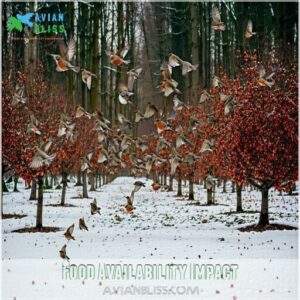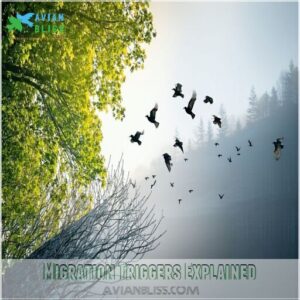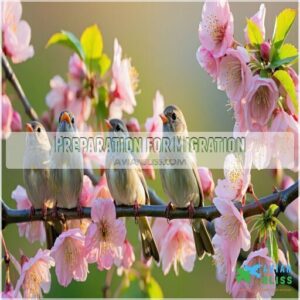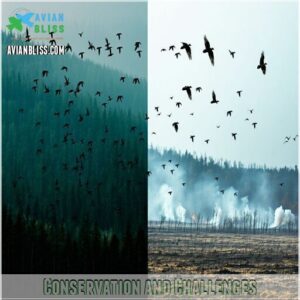This site is supported by our readers. We may earn a commission, at no cost to you, if you purchase through links.

When northern days shorten and temperatures drop, food sources like insects and berries become scarce. Your backyard birds aren’t just being dramatic—they’re following ancient instincts that guide them to warmer regions where food remains plentiful.
This remarkable journey helps them avoid harsh winter conditions that would otherwise threaten their survival. Some species travel thousands of miles, using the Earth’s magnetic field, stars, and landmarks to navigate with precision that would make your GPS jealous.
Their bodies undergo fascinating changes to prepare for these epic journeys.
Table Of Contents
- Key Takeaways
- Birds Migration Patterns
- Why Birds Migrate South
- Migration Triggers Explained
- Navigation Methods Used
- Preparation for Migration
- Migration Distance and Routes
- Conservation and Challenges
- Frequently Asked Questions (FAQs)
- Why do birds migrate south?
- Why do migratory birds fly south during winter?
- When do birds migrate?
- Why do birds migrate in spring?
- Why do birds fly south?
- What triggers birds to migrate?
- Why do only some birds fly south for the winter?
- What is the main reason that birds migrate?
- What birds do not migrate south for the winter?
- How do birds know to go south for the winter?
- Conclusion
Key Takeaways
- You’ll find birds migrate south primarily for food availability, not just to escape cold temperatures—they follow resources when northern food sources become scarce during winter months.
- Your backyard birds use remarkable navigation methods during migration, including magnetic field detection, celestial navigation using stars, and landmark recognition to find their way across thousands of miles.
- Before migrating, birds undergo essential physical changes including storing up to 40% more body weight as fat, developing specialized feathers for flight efficiency, and temporarily shrinking internal organs.
- You can help protect migrating birds by supporting habitat conservation at stopover sites, reducing light pollution that causes disorientation, and understanding how climate change increasingly disrupts their carefully timed migration patterns.
Birds Migration Patterns
You’ll notice bird migration patterns follow predictable routes as species travel thousands of miles between breeding and wintering grounds each year.
These journeys are primarily driven by food availability rather than temperature, with birds moving to areas where resources are plentiful during different seasons, which can be considered a key factor in their migration.
Food Availability Impact
Hunger drives the great journey south.
When you notice birds vanishing each fall, it’s primarily due to food availability—not just temperature. As insect scarcity increases in northern regions, birds migrate south where resources remain abundant.
Even seed-eating species face resource competition when winter tightens its grip. Birds carefully evaluate stopover nutrition sites, making dietary adaptations to fuel their long flights.
This seasonal food availability pattern has evolved over thousands of years, though climate change is now disrupting these ancient migration reasons that once guaranteed survival, based on the ancient migration.
Breeding Grounds Location
Beyond finding food, birds migrate to secure ideal habitats for raising their young.
Northern breeding grounds offer distinct advantages: longer summer daylight hours provide extra time for feeding hungry chicks, while less crowded nesting sites reduce competition for territory defense.
You’ll find that many species return to the exact same locations yearly, where specific nesting materials and food sources are abundant.
This loyalty to breeding grounds guarantees successful parental care and chick development.
The journey north isn’t just about survival—it’s about creating the next generation in locations perfectly suited to their needs.
Escape From Harsh Weather
When winter hits, it’s not just the chill that drives birds south—it’s Winter Resource Scarcity.
Many species can handle freezing temperatures, thanks to their Thermal Regulation abilities, but food vanishes as snow blankets the ground.
This lack of sustenance, paired with harsher weather conditions, makes survival tough.
Adaptations To Cold only go so far, so migration becomes essential.
Climate Change Impact further complicates things, altering patterns and intensifying the need for escape.
Why Birds Migrate South
Most birds migrate south for essential survival reasons, not just to escape cold weather.
Your backyard visitors are responding to natural instincts refined over millions of years.
- Southern food abundance becomes vital when northern resources deplete
- Wintering ground quality offers reliable shelter and nutrition
- Evolutionary advantages of migration outweigh the journey’s risks
- Reduced competition in southern regions improves survival chances
- Disease avoidance occurs as birds leave areas where pathogens might concentrate
This bird migration south follows ancient patterns, with each species having unique timing and routes.
Flyway usage patterns are key to understanding these routes.
When resources become scarce up north, the southern journey becomes a matter of life or death.
Migration Triggers Explained
You’ll notice birds don’t just randomly pack their feathered suitcases for southern vacations, but respond to specific environmental signals that trigger their migration instinct.
These triggers include changes in daylight hours (photoperiod), dropping temperatures, and the decreasing availability of food resources as winter approaches, which are all critical for their survival and can be considered environmental signals.
Photoperiod Changes
While exploring why birds head south, we can’t overlook nature’s most reliable migration trigger.
Ever notice how days grow shorter in late summer? Birds certainly do. This change in day length—the photoperiod—serves as their biological alarm clock for migration.
As daylight hours decrease, birds experience a fascinating condition called "Zugunruhe" or migratory restlessness.
This day length impact triggers hormonal shifts that prepare birds physically for their journey. Unlike temperature or food availability, photoperiod provides consistent seasonal cues that guarantee breeding synchronization and timely departures.
You might compare it to an ancient calendar system hardwired into their bodies—it’s why birds migrate with such predictable timing, regardless of whether your backyard still feels like summer.
Temperature Variations
Temperature acts as a vital supporting player in the bird migration story, even though day length is the star performer.
While many birds have impressive freezing tolerance, they still respond to climate influence and seasonal shifts.
- The bone-chilling winds make you grateful you’re not a tiny songbird facing winter.
- The silent thermometer drop signals life-or-death decisions for countless feathered families.
- The warm southern breezes call like a siren song to migration-ready birds.
- The harsh reality of thermal stress transforms familiar habitats into dangerous zones.
The latitudinal gradient of temperatures creates urgency, pushing birds southward before conditions become unbearable.
Food Scarcity Effects
Beyond temperature changes, food scarcity serves as the primary migration trigger for most birds.
When winter food shortages hit, you’ll notice species departing as insect populations vanish and seed availability changes.
Birds that can’t compete for limited resources must find alternative food sources elsewhere. This isn’t simply about avoiding cold—it’s about survival when food disappears.
Migration timing directly correlates with these seasonal declines, creating a precisely timed journey that climate disruptions increasingly challenge, which affects the overall migration trigger.
Navigation Methods Used
You’ll be amazed at how birds navigate thousands of miles without GPS, using Earth’s magnetic field, star patterns, and familiar landmarks to find their way.
Birds can actually see magnetic fields through special receptors in their eyes and detect changes in magnetic intensity through tiny magnetite crystals in their beaks, guiding them precisely to the same locations year after year, utilizing their innate ability to follow the magnetic fields.
Magnetic Field Detection
Like a tiny compass embedded in their bodies, birds possess remarkable avian magnetoreception abilities during migration.
They "see" magnetic fields through chemical processes in their optic nerve while simultaneously detecting field intensity via beak magnetite particles.
This dual geomagnetic sensing system provides birds with precise navigation cues without any external tools, allowing them to follow invisible magnetic pathways during their seasonal journeys.
You’d need sophisticated GPS technology to match what these feathered travelers accomplish naturally.
Many species also rely on celestial navigation using the sun and stars, which is a key aspect of their migration patterns.
Celestial Orientation
Looking up at the night sky, birds perform remarkable feats of celestial navigation during migration. They identify direction using star patterns and the moon’s position as reliable navigation cues.
When migrating, birds rely on three primary celestial methods:
- Using the sun as a compass during daylight hours
- Orienting by stellar patterns at about 95 degrees on clear nights
- Following the moon’s azimuth when visible
Diurnal species seamlessly switch between sun and star navigation, while nocturnal migrants depend heavily on the night sky—a system increasingly threatened by light pollution.
Landmark Recognition
Beyond magnetic fields, birds rely on landmarks for precise navigation. They recognize visual cues along migration routes, building detailed mental maps with each journey.
Birds aren’t just flying—they’re mapping the world with every wingbeat, creating aerial atlases no human could chart.
Your local landscape features prominently in bird migration navigation, with several key elements playing a crucial role:
- Coastlines serve as "highways" birds follow for thousands of miles
- Mountain silhouettes create distinctive profiles birds remember year after year
- Rivers provide both directional guidance and food-rich stopover points
- Human structures like radio towers become memorable markers in route memory
This navigational skill helps birds overcome urban obstacles while maintaining traditional migration routes through generational learning and habitat mapping.
Preparation for Migration
To prepare for migration, birds undergo remarkable changes in their bodies and behaviors. They store energy, adjust their diets, and develop physical adaptations to endure long journeys and shifting environments.
Energy Storage Strategies
For successful migration, birds employ strategic energy storage methods that maximize fuel efficiency for their long journeys.
| Strategy | Function | Example Species |
|---|---|---|
| Hyperphagia | Building fat reserves | Ruby-throated Hummingbird |
| Temperature Regulation | Lowering body temperature | Common Redpoll |
| Fat Catabolism | Converting fat to flight energy | Arctic Tern |
| Torpor | Conserving energy overnight | Poor-will |
| Protein Storage | Supporting muscle growth | Blackpoll Warbler |
During pre-migration, birds accumulate energy slowly through controlled overeating, storing essential nutrients as fat, which enables them to fuel their marathon flights. Offering birds high energy sustenance can aid in this important preparation, allowing them to replenish depleted reserves during stopover refueling points where their metabolic rates increase. This remarkable process is crucial for their survival, as it supports their ability to complete their journeys successfully, making energy storage and efficient fuel use vital components of their migration strategy.
Dietary Changes Needed
As birds prepare for their long journeys, their eating habits undergo remarkable changes.
While building on energy reserves, they modify their diets to maximize fat accumulation.
Pre-Migration Diet shifts are driven by bird migration reasons and food availability:
- Insectivorous warblers suddenly feast on fatty berries
- Seed-eaters incorporate protein-rich insects when available
- Shorebirds double their body weight through intensive feeding
- Hummingbirds switch from nectar to tiny insects for protein
- Waterfowl shift from aquatic plants to energy-dense seeds
This dietary flexibility helps birds overcome Insect Scarcity Impact in their home ranges.
Many species develop specialized digestive enzymes to process these Alternate Food Sources efficiently, highlighting the Fat Storage Importance for successful migration.
Supplementing their diet with high fat bird food can further aid in this vital preparation.
Physical Adaptations Required
Before taking flight, migratory birds transform their bodies through amazing physical adaptations. They develop specialized fat storage, increasing their weight by up to 40% with energy-rich deposits.
Their feather structure changes, providing better insulation and aerodynamics for flight. Muscle efficiency improves dramatically while internal organs temporarily shrink to reduce weight.
The bird’s circulatory system strengthens to handle physical stress during migration. You’ll find their entire physiology shifts to an energy conservation mode—their bodies becoming living fuel tanks and flight machines for their incredible journeys south.
Migration Distance and Routes
Birds follow specific migration routes that can span thousands of miles or just a few hundred, depending on their species and needs.
These paths, shaped by food availability and geography, guarantee they reach areas where survival is most likely, following routes that are a result of their species and needs.
Long Distance Migrants
With your body primed for travel, you’re now witnessing nature’s most remarkable travelers.
When it comes to long-distance migration, certain birds push the limits of endurance:
- Arctic terns cover 14,000+ miles annually between polar regions, the longest migration on Earth
- Northern wheatears travel 14,500km to Africa, utilizing genetic adaptations for efficient transoceanic flights
- Manx shearwaters journey 14,000km between northern breeding grounds and southern oceans
These migration patterns represent sophisticated survival strategies, helping birds escape harsh conditions while finding abundant resources. Many birds follow the Atlantic Flyway characteristics, utilizing coastal habitats to facilitate their long-distance migration and ensure efficient transoceanic flights.
Short Distance Migrants
While their long-distance relatives journey thousands of miles, short-distance migrants take a more measured approach to seasonal changes.
These practical travelers move just far enough to track resources and find warmer climates when local food supplies dwindle.
You’ll notice their migration patterns follow surprisingly direct routes, with most birds deviating only about 45 kilometers from their usual path.
As they mature, these birds develop increasingly precise navigation skills and demonstrate remarkable loyalty to their wintering sites, returning to the same habitat patches year after year without needing to cross oceans or continents.
Altitudinal Migration
Unlike their long-distance relatives, some birds practice altitudinal migration, moving up and down mountain slopes with the seasons.
You’ll notice these birds follow resource gradients as food supplies shift with elevation changes. The dusky grouse exemplifies this strategy by performing seasonal ascents mostly on foot, conserving energy while tracking available resources.
Mountain habitats offer natural corridors for these migrations, where birds can find food at different elevations throughout the year. Similar to emus that walk long distances during Australian droughts, these slope migrations demonstrate how birds adapt their seasonal patterns to local conditions, ensuring survival without crossing continents.
Conservation and Challenges
You’ll find that migratory birds face numerous threats on their journeys, including habitat loss, light pollution, and climate change that disrupt their carefully timed travels.
Your actions to protect stopover sites and reduce human-made hazards can help these remarkable travelers complete their seasonal migrations successfully, which is crucial for their survival and climate change mitigation.
Habitat Protection Importance
Birds need more than wings—they need safe places to land. That’s where stopover conservation becomes a game-changer. Protecting bird migration habitats guarantees survival for species journeying thousands of miles annually.
Imagine your local wetland as an oasis for exhausted travelers, offering food and shelter after marathon flights. Safeguarding these stopover habitats isn’t just vital for birds—it helps ecosystems thrive and benefits your community too.
Protecting these areas can involve purchasing specialized habitat products to further support conservation efforts.
- Flyway protection preserves critical resting and feeding areas along migration routes.
- Conserved breeding habitats boost bird populations long-term.
- Wintering grounds provide seasonal refuge, preventing starvation and stress.
- Intact habitats deliver ecosystem services like water filtration and air purification.
- Bird conservation investments preserve biodiversity, supporting countless species.
Without habitat protection, countless birds might lose the natural pit stops essential for survival. Save birds, save nature—it’s all connected.
Human Impact on Migration
Human activities impact bird migration in five major ways, creating obstacles that threaten millions of birds annually.
Light pollution from cities confuses nocturnal migrants, causing fatal disorientation—programs like "Lights Out" encourage buildings to dim unnecessary lighting during peak migration.
Communication towers and tall buildings cause deadly collisions, while habitat loss eliminates essential stopover sites where birds rest and refuel.
Many communities now implement bird-friendly design standards to reduce these hazards.
Bird-friendly design
You can help by turning off unnecessary lights at night, applying window films to prevent collisions, and supporting conservation efforts that preserve migration traps—areas where birds naturally concentrate during their journeys.
Climate Change Effects
Climate change is rewriting migratory birds’ ancient playbook, forcing them to adapt—or risk survival.
You’re seeing these shifts everywhere:
- Mismatched Timing: Birds now arrive at breeding grounds 5-10 days earlier than the 1970s.
- Shifting Habitats: Environmental changes push birds to abandon familiar routes, creating uncertainty.
- Altered Routes: Some species no longer migrate, staying in warmer winter regions instead.
- Species Vulnerability: Food sources vanish as seasons change unpredictably, leaving birds hungry.
- Extreme Weather: Intense storms and rising seas devastate critical stopover sites.
These shifts highlight the impact of rising temperatures on avian species.
Bird migration hazards reflect an urgent need for conservation, as these feathered travelers face unprecedented environmental challenges tied to our warming world.
Frequently Asked Questions (FAQs)
Why do birds migrate south?
In an epic survival journey, you’ll find birds heading south mainly for food, not just warmth.
When winter depletes northern resources, they’re forced to seek regions where insects and other food remain available, which can be considered a complete concept of survival.
Why do migratory birds fly south during winter?
You’ll find these feathered travelers heading south primarily for food, not warmth.
When winter depletes northern resources, they’re simply following their next meal to regions where insects and plants remain abundant.
When do birds migrate?
Like clockwork, birds migrate primarily in spring and fall.
You’ll see them heading north in March-May for breeding and south in August-November as they seek warmer regions with abundant food supplies, which can be considered a complete concept in understanding their migration patterns.
Why do birds migrate in spring?
Birds migrate in spring to reach northern breeding grounds where you’ll find longer days, abundant food sources, and fewer predators.
They’re returning to establish territories and nest in areas with ideal conditions for raising their young, which includes having abundant food sources.
Why do birds fly south?
As nature’s compass points south, you’ll see birds flying there primarily to find food.
When winter depletes northern resources, they’re compelled to seek abundant meals and better survival conditions in warmer regions.
What triggers birds to migrate?
You’re witnessing a natural alarm clock at work.
Changing daylight hours, dropping temperatures, and dwindling food supplies trigger internal biological changes that signal it’s time to pack up and journey southward.
Why do only some birds fly south for the winter?
Ever wondered why your backyard isn’t completely empty each winter?
Not all birds migrate because they’ve adapted to find sufficient food year-round, while others must travel south when their primary food sources become scarce.
This difference in behavior is largely driven by the availability of primary food sources.
What is the main reason that birds migrate?
The primary reason for bird migration is food availability.
You’ll find that birds travel to regions where resources are plentiful, especially when seasonal changes make their current habitat unsuitable for feeding and survival.
What birds do not migrate south for the winter?
Like steadfast sentries, permanent residents such as chickadees, cardinals, and woodpeckers don’t pack their bags for winter.
You’ll find these hardy birds year-round, as they’ve adapted to find food even when snow blankets their homes.
How do birds know to go south for the winter?
Birds sense changing day length through their pineal gland, triggering migration.
They navigate using the sun, stars, Earth’s magnetic field, and landmarks.
This innate ability is often combined with learned behavior from previous journeys.
Conclusion
While humans invest in winter gear and heated homes, birds solve cold-weather challenges differently—they simply leave.
Now you understand why birds migrate south: it’s a finely-tuned survival strategy balancing food availability, breeding needs, and weather avoidance.
This remarkable journey, guided by nature’s GPS systems, represents one of Earth’s most spectacular phenomena.
Next time you spot birds heading south, you’ll appreciate the incredible instincts and physiological marvels driving their seasonal travels.











